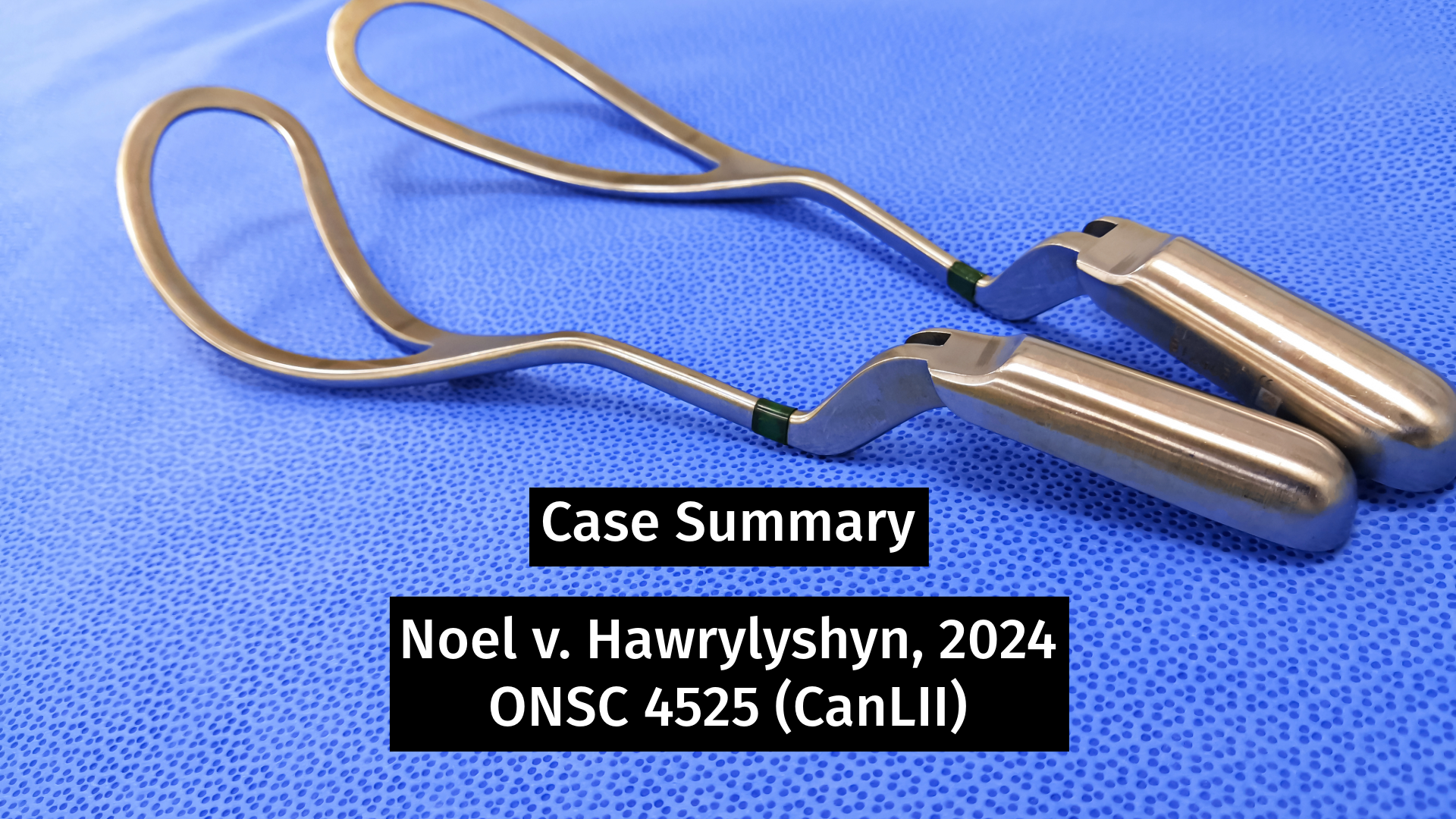This was a medical malpractice trial decision of the Honourable Justice W.N. Renke of Edmonton, Alberta arising from a family doctor’s failure to refer a high-risk twin pregnancy to an obstetrician for ongoing obstetrical management. As a result of the failure to refer, the Court found that the diagnosis of a twin-to-twin transfusion syndrome (“TTTS”) was delayed which resulted in profound and severe disability to both twins.
TRIAL DECISION
Standard of Care
The trial judge determined that the defendant Dr. Bahler failed to meet the standard of care of a family physician whose practice was restricted to low-risk pregnancies by failing to refer the pregnant mother of twins to an obstetrician upon learning that she was pregnant with monochorionic (shared placenta) diamniotic (own amniotic sac) twins.
Monochorionic diamniotic twin pregnancies are considered high risk.
On August 11, 2009, Dr. Bahler recognized the need for a referral and started a referral letter for the pregnant mother. However, the referral letter was never completed or sent. The mother even contacted Dr. Bahler’s office to check on the referral which still did not result in its completion.
Causation
As a result of the failure to refer to an obstetrician to manage the diagnosed monochorionic diamniotic twin pregnancy, the mother ended up presenting in distress at Red Deer Regional Hospital on September 3, 2009. Twenty three (23) days had passed since her last appointment with the Defendant doctor who had still not facilitated the necessary referral.
At the time of her presentation, the twins were suffering from a severe stage of TTTS. Essentially, while in utero, blood flow was transfused or transferred from one twin to the other. Blood flow to one twin was excessive and to the other deficient. This condition if left untreated may result in fetal demise of one or both twins.
Despite best efforts, including transfer to Foothills Medical Centre in Calgary and transfer by air ambulance to Mt. Sinai Hospital in Toronto, no surgical intervention to address the twins’ condition was feasible. As such, the twins were born naturally and prematurely, suffering neurodevelopmental injuries.
The Court found that if Dr. Bahler had referred the pregnant mother to an obstetrician upon discovering the high-risk nature of the pregnancy, the twins’ injuries would have been less than the injuries they actually suffered for the following reasons:
(a) Either through ultrasound surveillance by the obstetrician or through the mother raising concerns with the obstetrician respecting her worsening condition or both, the twins’ emerging TTTS would have been detected at a sufficiently serious stage to warrant intervention and would have been detected earlier than it actually was.
(b) While the TTTS in this case was not chronic but evolved acutely, the condition still required the formation of a physical infrastructure and sufficient time – even if measured only in days – to progress to the severe stage manifest when the mother presented at Red Deer Regional Hospital.
(c) Because of the nature of the progress of the TTTS, the twins would not have been injured by TTTS at the time of its detection.
(d) The surgical procedure used to address the TTTS would have been selective fetoscopic laser photocoagulation (“SFLP”).
(e) At the time the TTTS was detected, KY would have been eligible for SFLP. She would not have been in labour and an anterior placenta would not have precluded the procedure.
(f) The twins’ gestational age would not have precluded the procedure at Mt Sinai Hospital.
(g) The SFLP itself would not have harmed the twins and both would have likely survived the procedure.
(h) The SLFP would have corrected the circulatory imbalances caused by TTTS putting the twins at risk and would have reduced amniotic fluid pressure. TTTS would not thereafter have harmed the twins.
(i) KY’s pregnancy would have been prolonged.
(h) Because their period of gestation would have been prolonged, the injuries the twins suffered through being born prematurely would have diminished.
Damages
The twins suffered periventricular leukomalacia (“PVL”), which is damage to the white matter around the brain’s ventricles. The periventricular white matter region is the white matter adjacent to the posterior parts of the ventricles.
PVL is an “hypoxic-ischemic” brain injury. Hypoxia refers to decreased oxygen in blood. Ischemia refers to decreased delivery of blood to the brain. Hypoxia and ischemia typically occur together. The less mature the baby, the less well formed the baby’s blood vessels and the more vulnerable the baby is to injury. If there is decreased blood flow to the brain or decreased oxygen delivered in blood flowing to the brain, brain tissue will be injured. The brain tissue swells after the insult. Cells that cannot recover die. The brain tissue is scarred and destruction of circuits may occur. The scarring that occurs when brain cells die limits the ability of the brain to use those pathways for motor movement or cognitive function.
As a result, both twins suffer from cerebral palsy. One twin’s affliction is more profound. She relies on a power wheelchair. She has severe cerebral palsy affecting her right arm and both legs.
The other twin has cerebral palsy with “right spastic hemiplegia” with lower extremity involvement. She wears a supportive leg brace on her right leg.
While the twins’ limitations differ, both are cognitively impaired. Both have difficulties in executive functioning. Both have language difficulties. Both have impaired fine motor and gross motor skills.
Damages were partially settled prior to trial so the total damages awarded is not known.
EXPERT WITNESSES
Plaintiffs’ Experts
Dr. Richard Brown was qualified as a medical doctor specializing in obstetrics and gynecology, with a subspecialty in maternal fetal medicine, in particular relating to TTTS and fetal surgery.
Dr. David Kason was qualified as a medical doctor specializing in family medicine, particularly respecting prenatal care and obstetrical care, and as a family physician working in an emergency setting.
Dr. Derek Armstrong was qualified to provide expert evidence relating to pediatric neuroradiology, relating to the interpretation of brain imaging, to provide expert evidence relating to the causes of abnormalities found on brain imaging.
Dr. Andrew Macnab was qualified as a medical doctor specializing in the areas of pediatrics and neonatology and was entitled to testify concerning the mechanism of the brain injury suffered by the twins.
Dr. Michael Freeman was qualified to give opinion evidence within the area of epidemiology.
Defence Experts
Dr. Nancy Vyse was qualified as an expert in family medicine to give evidence on the standard of care for a family practitioner, including obstetrical care and the practice of family medicine in an emergency department.
Dr. Jon Barrett was qualified as a medical doctor specializing in the area of obstetrics, with a sub specialization in the area of maternal-fetal medicine, with expertise in the diagnosis and management of twin pregnancy including twin pregnancies and twin-to-twin transfusion syndrome, qualified to provide opinion evidence on standard of care and causation
Dr. Michael Sargent was qualified as an expert in pediatric radiology, pediatric neuroradiology, with expertise in reading ultrasound and MRI imaging of the neonatal brain, as well as the cause and timing of brain injuries in the neonate based on imaging.
Dr. Louis Beaumier was qualified as a medical doctor specializing in pediatrics and neonatology and to give evidence within those areas, including the likely cause of the brain injury suffered by the twins.
Dr. Gordon Chambers was qualified in the area of epidemiology, as it relates to the issues in dispute in this case, particularly to instances of neurodevelopmental impairment as a result of TTTS or extreme premature birth.
Decision Date: May 8, 2023
Jurisdiction: Court of King’s Bench Alberta
Citation: KY v Bahler, 2023 ABKB 280



